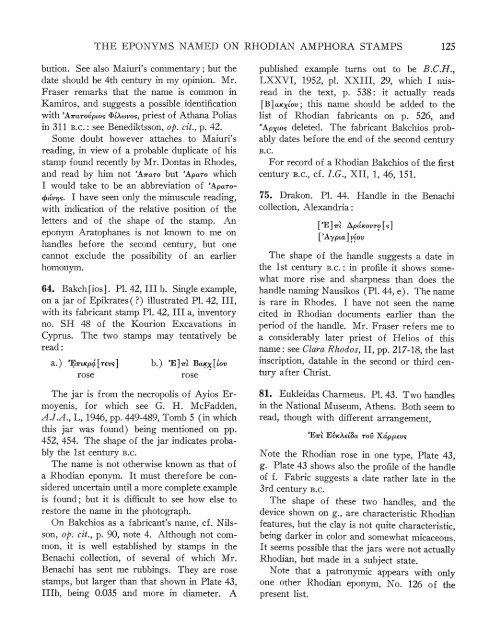the eponyms named on rhodian amphora stamps - The American ...
the eponyms named on rhodian amphora stamps - The American ...
the eponyms named on rhodian amphora stamps - The American ...
You also want an ePaper? Increase the reach of your titles
YUMPU automatically turns print PDFs into web optimized ePapers that Google loves.
THE EPONYMS NAMED ON RHODIAN AMPHORA STAMPS 125<br />
buti<strong>on</strong>. See also Maiuri's commentary; but <str<strong>on</strong>g>the</str<strong>on</strong>g><br />
date should be 4th century in my opini<strong>on</strong>. Mr.<br />
Fraser remarks that <str<strong>on</strong>g>the</str<strong>on</strong>g> name is comm<strong>on</strong> in<br />
Kamiros, and suggests a possible identificati<strong>on</strong><br />
with 'A7rarovptovo J4bXvog, priest of Athana Polias<br />
in 311 B.C.: see Benediktss<strong>on</strong>, op. cit., p. 42.<br />
Some doubt however attaches to Maiuri's<br />
reading, in view of a probable duplicate of his<br />
stamp found recently by Mr. D<strong>on</strong>tas in Rhodes,<br />
and read by him not 'A7raro but 'Aparo which<br />
I would take to be an abbreviati<strong>on</strong> of 'Aparo-<br />
4acvry. I have seen <strong>on</strong>ly <str<strong>on</strong>g>the</str<strong>on</strong>g> minuscule reading,<br />
with indicati<strong>on</strong> of <str<strong>on</strong>g>the</str<strong>on</strong>g> relative positi<strong>on</strong> of <str<strong>on</strong>g>the</str<strong>on</strong>g><br />
letters and of <str<strong>on</strong>g>the</str<strong>on</strong>g> shape of <str<strong>on</strong>g>the</str<strong>on</strong>g> stamp. An<br />
ep<strong>on</strong>ymn Aratophanes is not known to me <strong>on</strong><br />
handles before <str<strong>on</strong>g>the</str<strong>on</strong>g> sec<strong>on</strong>d century, but <strong>on</strong>e<br />
cannot exclude <str<strong>on</strong>g>the</str<strong>on</strong>g> possibility of an earlier<br />
hom<strong>on</strong>ym.<br />
64. Bakch [ios]. P1. 42, III b. Single example,<br />
<strong>on</strong> a jar of Epikrates ( ?) illustrated P1. 42, III,<br />
with its fabricant stamp P1. 42, III a, inventory<br />
no. SH 48 of <str<strong>on</strong>g>the</str<strong>on</strong>g> Kouri<strong>on</strong> Excavati<strong>on</strong>s in<br />
Cyprus. <strong>The</strong> two <strong>stamps</strong> may tentatively be<br />
read:<br />
a.) 'E7rLKp[TEVS] b.) 'E] 7rt BaKX[t'oV<br />
rose rose<br />
<strong>The</strong> jar is from <str<strong>on</strong>g>the</str<strong>on</strong>g> necropolis of Ayios Er-<br />
moyenis, for which see G. H. McFadden,<br />
A.J.A., L, 1946, pp. 449-489, Tomb 5 (in which<br />
this jar was found) being menti<strong>on</strong>ed <strong>on</strong> pp.<br />
452, 454. <strong>The</strong> shape of <str<strong>on</strong>g>the</str<strong>on</strong>g> jar indicates proba-<br />
bly <str<strong>on</strong>g>the</str<strong>on</strong>g> 1st century B.C.<br />
<strong>The</strong> name is not o<str<strong>on</strong>g>the</str<strong>on</strong>g>rwise known as that of<br />
a Rhodian ep<strong>on</strong>ym. It must <str<strong>on</strong>g>the</str<strong>on</strong>g>refore be c<strong>on</strong>-<br />
sidered uncertain until a more complete example<br />
is found; but it is difficult to see how else to<br />
restore <str<strong>on</strong>g>the</str<strong>on</strong>g> name in <str<strong>on</strong>g>the</str<strong>on</strong>g> photograph.<br />
On Bakchios as a fabricant's name, cf. Nils-<br />
s<strong>on</strong>, op. cit., p. 90, note 4. Although not com-<br />
m<strong>on</strong>, it is well established by <strong>stamps</strong> in <str<strong>on</strong>g>the</str<strong>on</strong>g><br />
Benachi collecti<strong>on</strong>, of several of which Mr.<br />
Benachi has sent me rubbings. <strong>The</strong>y are rose<br />
<strong>stamps</strong>, but larger than that shown in Plate 43,<br />
IIIb, being 0.035 and more in diameter. A<br />
published example turns out to be B.C.H.,<br />
LXXVI, 1952, pl. XXIII, 29, which I misread<br />
in <str<strong>on</strong>g>the</str<strong>on</strong>g> text, p. 538: it actually reads<br />
[B]aKXtOV;<br />
this name should be added to <str<strong>on</strong>g>the</str<strong>on</strong>g><br />
list of Rhodian fabricants <strong>on</strong> p. 526, and<br />
3'ApXtog deleted. <strong>The</strong> fabricant Bakchios probably<br />
dates before <str<strong>on</strong>g>the</str<strong>on</strong>g> end of <str<strong>on</strong>g>the</str<strong>on</strong>g> sec<strong>on</strong>d century<br />
B.C.<br />
For record of a Rhodian Bakchios of <str<strong>on</strong>g>the</str<strong>on</strong>g> first<br />
century B.C., cf. I.G., XII, 1, 46, 151.<br />
75. Drak<strong>on</strong>. P1. 44. Hlandle in <str<strong>on</strong>g>the</str<strong>on</strong>g> Benachi<br />
collecti<strong>on</strong>, Alexandria:<br />
['E] rL ApaKovro[s]<br />
['Aypta] itov<br />
<strong>The</strong> shape of <str<strong>on</strong>g>the</str<strong>on</strong>g> handle suggests a date in<br />
<str<strong>on</strong>g>the</str<strong>on</strong>g> 1st century B.C.: in profile it shows some-<br />
what more rise and sharpness than does <str<strong>on</strong>g>the</str<strong>on</strong>g><br />
handle naming Nausikos (P1. 44, e). <strong>The</strong> name<br />
is rare in Rhodes. I have not seen <str<strong>on</strong>g>the</str<strong>on</strong>g> name<br />
cited in Rhodian documents earlier than <str<strong>on</strong>g>the</str<strong>on</strong>g><br />
period of <str<strong>on</strong>g>the</str<strong>on</strong>g> handle. Mr. Fraser refers me to<br />
a c<strong>on</strong>siderably later priest of Helios of this<br />
name: see Clara Rhodos, II, pp. 217-18, <str<strong>on</strong>g>the</str<strong>on</strong>g> last<br />
inscripti<strong>on</strong>, datable in <str<strong>on</strong>g>the</str<strong>on</strong>g> sec<strong>on</strong>d or third cen-<br />
tury after Christ.<br />
81. Eukleidas Charmeus. P1. 43. Two handles<br />
in <str<strong>on</strong>g>the</str<strong>on</strong>g> Nati<strong>on</strong>al Museum, A<str<strong>on</strong>g>the</str<strong>on</strong>g>ns. Both seem to<br />
read, though with different arrangement,<br />
'E7rt EWKXd&a TOv Xa4p,LEv<br />
Note <str<strong>on</strong>g>the</str<strong>on</strong>g> Rhodian rose in <strong>on</strong>e type, Plate 43,<br />
g. Plate 43 shows also <str<strong>on</strong>g>the</str<strong>on</strong>g> profile of <str<strong>on</strong>g>the</str<strong>on</strong>g> handle<br />
of f. Fabric suggests a date ra<str<strong>on</strong>g>the</str<strong>on</strong>g>r late in <str<strong>on</strong>g>the</str<strong>on</strong>g><br />
3rd century B.C.<br />
<strong>The</strong> shape of <str<strong>on</strong>g>the</str<strong>on</strong>g>se two handles, and <str<strong>on</strong>g>the</str<strong>on</strong>g><br />
device shown <strong>on</strong> g., are characteristic Rhodian<br />
features, but <str<strong>on</strong>g>the</str<strong>on</strong>g> clay is not quite characteristic,<br />
being darker in color and somewhat micaceous.<br />
It seems possible that <str<strong>on</strong>g>the</str<strong>on</strong>g> jars were not actually<br />
Rhodian, but made in a subject state.<br />
Note that a patr<strong>on</strong>ymic appears with <strong>on</strong>ly<br />
<strong>on</strong>e o<str<strong>on</strong>g>the</str<strong>on</strong>g>r Rhodian ep<strong>on</strong>ym, No. 126 of <str<strong>on</strong>g>the</str<strong>on</strong>g><br />
present list.

















